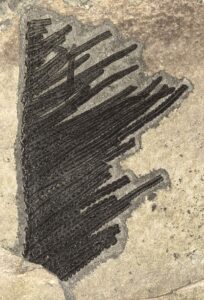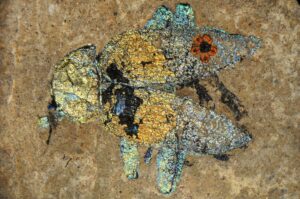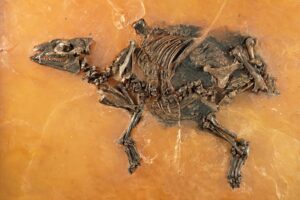Introduction
When the first fossil, a crocodilian, was discovered in 1875 in the oil-shale deposit now known as the Messel Pit (Smith et al. 2018b), or “Messel” for short, it is certain that no one could predict the future importance of the site for science. Since that time, a vast trove of fossils, numbering in the many tens of thousands (Uhl et al. 2018), has been discovered and conserved. This effort continues. The deposit has been precisely dated to the early-middle Eocene boundary interval. And more generally, the climate of this time has been recognized as a “greenhouse climate” (e.g., Burke et al. 2018), one characterized by high atmospheric CO2 concentrations, higher overall temperatures, and lower seasonality. Messel is thus a window into the kind of world into which anthropogenic climate change may lead us in (geologically speaking) a breathtakingly short time.
Located near Frankfurt am Main, Germany, Messel represents an ancient maar lake, like those in the Volcanic Eifel and other areas (Fig. 1) today, created by volcanic eruptions 48.2 million years ago (Lenz et al. 2015). While the oblong pit today is less than 1 km in extent, the lake may once have been much larger (Büchel and Schaal 2018). The oil-shale comprises very fine laminae of clay minerals and organic remains, which were laid down at a rate of about 0.14 mm/yr (after compaction). The light part of the year is represented mostly by remains of a green alga, Tetraedron minimum, whereas mostly clay minerals were deposited in the dark part of the year when photosynthesis was depressed. Essentially all fossils come from this oil-shale.

Figure 1. The margin of Lake Messel might have looked like Longwan, China, a modern example of a maar lake. Photograph: Stephan Schaal.
Messel belongs to a class of deposits known as Konservat-Lagerstätten, or “conservation deposits,” which are characterized by a very high quality of preservation (see below). However, the excavation of these deposits is time-intensive, and for many decades the Messel Pit was operated only by mining interests – similar to Solnhofen in southern Germany or Quercy in France. Specifically, at Messel, economically valuable organic compounds (such as fossil fuels) were won from the oil-shale (Schaal and Schneider 1995). While miners could not overlook large fossils in the oil-shale, a special technique had to be developed to transfer the fossils onto liming wax or synthetic resins. This prevents the destruction of the fossils that would otherwise occur by the desiccation of the oil-shale. Plants and soft-bodied animals like insects, on the other hand, are typically conserved on oil-shale submerged in glycerin, which also protects the fossils from desiccation. By use of this technique the fossils of Messel had become well known by the 1970s, when mining operations permanently ceased. In 1995, Messel was inscribed on the list of UNESCO World Heritage sites.
How did Messel Come to Be?
Messel is situated on a kind of broad, fault-bounded ridge (horst) on the margin of the Upper Rhine Graben. The region was volcanically active during the Eocene, and numerous eruptions are documented (Schumacher 2002). In some of these, groundwater contacted near-surface magma, explosively vaporizing and ejecting overlying rock to form a crater that rapidly filled with water, forming a maar lake. Such eruptions are called “phreatomagmatic.” The origin of Messel can be traced to just such an eruption (Schulz et al. 2002).
When the eruption had ceased – in truth it probably occurred in steps that lasted for days or weeks – the landscape surrounding the crater was a wasteland of volcanic debris. The lake margins were stabilized by pioneering vegetation like ferns (Fig. 2) (Lenz et al. 2007). At this point, the lake water was well mixed and fully oxygenated. However, mixing slowed, and the deeper waters were cut off from the atmosphere within a few hundred years. At this point, a permanent stratification became established. While the upper few meters of water were well mixed, the vast lower part of the lake was not; in that lower part the oxygen was depleted, and no multicellular life could continue to live in it. This “stratified” state of the lake was maintained for over a million years and is responsible for the formation of the oil-shale (Goth 1990).

Figure 2. Fern frond from Messel. Specimen in the collections of the Senckenberg Research Institute. Photograph: Martin Müller.
By the time the oil-shale was forming, a dense, multi-level forest surrounded Lake Messel. Swampy areas are indicated close to the margins. At the edge of the lake, as well as in treefall gaps, woody vines were abundant. There is indirect evidence for dryer, upland areas far afield. The organisms – animals, plants and fungi – preserved in the Middle Messel Formation are a mixture that originally lived in Lake Messel itself, along the shore, and in the surrounding forest (Smith et al. 2018c).
How did Organisms Come to be Preserved?
While water-dwelling organisms like aquatic insects and fishes would have died in the lake itself, plant organs like pollen and leaves were presumably blown into the lake or carried thither by small streams. Terrestrial animals presumably suffered the same fate. All these terrestrial elements of the surrounding community had to be transported to the center of the lake and sink.
It is not yet fully clear why all the terrestrial animals died. There are three main explanations: (1) accidental drowning as a null hypothesis (Smith and Wuttke 2012); (2) asphyxiation (Franzen 1985); and (3) drinking of poisoned water (Koenigswald et al. 2004). Asphyxiation could have occurred in a dense layer of CO2 overlying the water that might have occasionally formed through continuing volcanic activity, as in the well-known case of Lake Nyos in Cameroon. Poisoning could have occurred from secondary metabolites of certain cyanobacteria that sometimes proliferate in massive blooms; however, the occurrence of these cyanobacteria has not been ascertained at Messel. Mysteries remain on this score.
What Fossils Are Found at Messel?
Fossils of unicellular, water-dwelling organisms are vastly more common than anything else, and by far the most common of these is the green alga Tetraedron minimum. Indeed, a significant fraction of the oil-shale is made up of the remains of its cell walls (Goth 1990). Members of this lineage, with living relatives in places like the Sea of Galilee, look like minuscule, square cushions, one-hundredth of a millimeter in size. In some layers, other unicellular organisms like dinoflagellates are abundant, and still others like diatoms are also known.
Flowering plants had been diversifying since the Early Cretaceous, so it is hardly surprising that Messel yields a very diverse flora. As in other deposits, land plants are represented by microscopic pollen and spores as well as macroscopic leaves and fronds (Fig. 2), flowers (Fig. 3), fruits and rarely wood (Wilde 2018). Particularly abundant groups are the laurel, moon seed, walnut, and grapevine families. A primitive water lily, recently described as Nuphaea (Gee and Taylor 2019), probably grew in stands near the lake edge. Palms grew in abundance, as shown by a large number of flowers. Among the more vivid fossils are flowers belonging to the citrus family. Although the great majority of fossil species probably lived very close to Lake Messel, some (like the beech family) are known only from wind-blown pollen, suggesting they occupied distant, probably upland, areas. Most plant taxa at Messel have modern relatives in tropical and subtropical latitudes (Collinson et al. 2012).

Figure 3. This darkling beetle, Ceropria messelense, is relatively common at Messel. A small flower is preserved coincidentally on one wing-cover. The beetle is c. 2 cm long. Specimen in the collections of the Senckenberg Research Institute. Photograph: Uta Kiel.
Among the invertebrate animals are rarities like snails and sponges. The latter are known principally by the tiny siliceous spines (spicules) that make up their skeleton; these are extremely abundant in certain layers, called “spiculites" (Richter and Wuttke 1999). Spiders, harvestmen and crustaceans (including seed shrimp and freshwater shrimp) have also been found (Wedmann 2018; Selden and Wappler 2019).
Yet far and away the most abundant invertebrates in Messel, as in modern terrestrial ecosystems, are insects (Wedmann 2018). Well over 20,000 have been collected thus far. Every major group of insects is known at Messel: basal winged groups like mayflies and dragonflies that cannot fold their wings; earwigs, grasshoppers and termites; flies, butterflies, ants, bees and beetles (Fig. 3). One spectacular discovery is that of a male walking leaf (Phasmatodea), which like its extant relatives was camouflaged to look like a leaf (Wedmann et al. 2007).
The fishes of Lake Messel are extremely common but poor in species (Micklich 2012). Two groups (gars and bowfins) known from Messel were widespread in North America and Europe in the Eocene and are now confined to the warmer latitudes of North America and Cuba. They are bimodal breathers, able to breath air and absorb oxygen through their gills, which allows them to flourish even in hypoxic waters. Several further lineages of teleost fish are also known, which show different feeding specializations. Of the thousands of fish fossils that have been unearthed, a single specimen of an eel was recovered.
Several frog and two salamander species are known (Wuttke 2018). Surprisingly, the most common frog species is not an aquatic one but rather is a terrestrial one related to European spadefoot toads. In contrast to another lake deposit in Germany, Enspel, where large numbers of tadpoles have been recovered (Roček and Wuttke 2010), tadpoles are extremely rare at Messel, suggesting that development of these amphibians generally took place elsewhere.
The diversity of reptiles, over 30 and counting, is astonishing considering their low species diversity in Europe today. The lizards and snakes include numerous lineages known from the Neotropics, like small and large boas (Fig. 4) and basilisks (Smith et al. 2018a; Scanferla and Smith 2020), but also an endemic European radiation of species related to Lacertidae. Among them are semiaquatic, cryptic ground-dwelling, open terrestrial and arboreal species. At least two lizard species had prehensile tails. Recently a python relative, Messelopython, was recognized, and unexpectedly it occurred together with boas (Zaher and Smith 2020).

Figure 4. Skeleton of the large (2-m long) boa Eoconstrictor fischeri from Messel containing a small crocodilian. The photograph is of a cast; the original is in the collections of the Museumsverein (Museum Society), Messel. Photograph: Anika Vogel.
The turtles of Messel, like in habitats everywhere today, are not particularly diverse with regard to the number of species, but they include fully aquatic species as well as semiaquatic ones (Cadena et al. 2018). Seven species of crocodilian have been discovered (Brochu and Miller-Camp 2018). Most of them are very rare and may have been only transients. However, one species, Diplocynodon darwini, is abundant and, since juvenile and adult specimens known, may have been a resident. The so-called ‘hoofed’ crocodile, Boverisuchus, was probably terrestrial, showing that the range of adaptations in Eocene crocodilians was much greater than today.
More species of bird are known from Messel than of any other major vertebrate group (Mayr 2017). To be sure, it was potentially easier for birds to become fossilized than other groups, as they flew over the lake, but this diversity nevertheless shows that the radiation of birds was well underway some 18 million years after the extinction of the big dinosaurs and their flying relatives, the pterosaurs, at the end of the Cretaceous. Groups like nightjars, swifts, hummingbirds, parrots, passerines, trogons, hoopoes, rollers, kingfishers, and mousebirds are well documented. Several flightless species are known, including the probably herbivorous Gastornis (Angst et al. 2014). The most abundant of them is the Messel rail, Messelornis cristata.
The diversity of mammals likewise shows that their radiation also was well underway. Best known, perhaps, is the Messel horse, Eurohippus messelensis (Fig. 5), which is represented by dozens of specimens (Franzen 2007). This dog-sized species retained four fingers and three toes (all but one are effectively lost in modern horses) and was adapted for eating leaves rather than grass. But many other groups are known as well, such as small insectivores, primitive artiodactyls, rodents (one of which was dog-sized), and relatives of today’s pangolins. Bats are extremely numerous, probably because they, like birds, flew over the lake; the seven described species show not only divergent flight adaptations but also different echolocation abilities (Habersetzer et al. 1994). The fossil Darwinius, described to great fanfare in 2009, is the most complete early primate yet discovered (Franzen et al. 2009).

Figure 5. Skeleton of the primeval horse relative Eurohippus messelensis from Messel, which represents a pregnant mare with a foetus. Specimen in the collections of the Senckenberg Research Institute. Photograph: Anika Vogel.
What Do We Learn from Messel?
One of the most important things Messel has to teach us is how ecosystems functioned under climatic conditions similar to those the Earth may experience within the next 200 years (Burke et al. 2018). The species diversity of many ectothermic groups of animals is exceptional. Reptiles, for instance, were at least three times as diverse in the tiny habitat around Messel than in all of Germany today. More than 150 vertebrate species are currently known from Messel. This diversity takes on special significance when one considers that only 18 million years had elapsed since the extinction of the big dinosaurs and the devastation of terrestrial ecosystems at the end of the Cretaceous.
Moreover, the exceptional fidelity of preservation at Messel allows us to begin to disentangle their trophic relations and understand their paleobiology in detail. For example, gut contents of the large boa Eoconstrictor fischeri, which reached over 2 meters in length, show that it preyed on basilisks and on crocodilians (Fig. 4) (Greene 1983; Smith and Scanferla 2016) – like in Florida today, where feral pythons are known to prey on native alligators. A further example is the elucidation of feeding behavior of an extinct fly, Hirmoneura messelense (Wedmann et al. 2021). The pollen preserved in the crop showed not only what it ate but also what its preferred feeding habitat was: along forest and lake margins. A final example is the reproductive biology of the horse Eurohippus messelensis. Several specimens of pregnant mares have been recovered, including the one shown here (Fig. 5).
Conclusions
The world is changing rapidly. According to more pessimistic models, large parts of the Earth may experience conditions like those of the Eocene by the year 2200, including large parts of central Europe (Burke et al. 2018). Humankind has never experienced such a greenhouse climate, much less in the scientific age, so it is difficult to anticipate what may becoming. In another way of thinking, however, the Eocene represents a kind of natural experiment, and careful study of that experiment may help us anticipate — assuming current emissions trends are not reversed. Reconstructions of paleoclimate at Messel based on oxygen isotopes are tending toward a mean annual temperature of somewhat below 20 ºC; Tütken (2014) gives it as 18 ºC ± 2.5 ºC, consistent with one estimate based on the nearest living relatives of Messel plants (Grein et al. 2011). Given the mean annual temperature at Messel today, about 9.6 ºC (WorldClim 1 dataset), an increase in temperature of 5 ºC puts this piece of central Europe within the projected climatic range for the year 2100 and later under more pessimistic CO2 emissions scenarios. Because of the abundance and exceptional preservation of fossils belonging to virtually all macroscopic members of the surrounding community, Messel arguably holds the greatest potential for understanding how an ecosystem functioned during the extraordinary time of the Eocene.
Acknowledgments
I thank Dan Grigorescu for the invitation to contribute to this volume, Marie-Luise Frey of the Visitors’ Center at Messel, and the State of Hesse and its ministries and agencies for their continuing support of the excavations at Messel. Torsten Wappler and Eberhard “Dino” Frey provided valuable comments on an earlier version of this paper, and Michael Benton and journal staff made helpful editorial comments.
Conflict of Interest
I declare no conflicts of interest.
